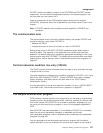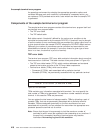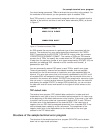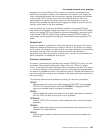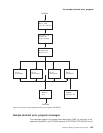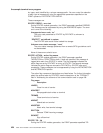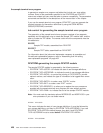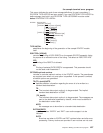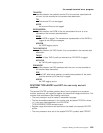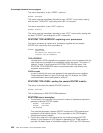
This message contains the symbolic terminal ID of the device associated with
the error. This message can be suppressed by using the NOTID option.
DFHTEP, DECB - DECB information
During the DFHTEP module generation, the PRINT parameter specified DECB.
This two-line message contains the DECB (printed in hexadecimal format) of
the terminal causing the error. The DECB is contained in the TACLE
(displacement +16 [decimal]). See the TACLE DSECT described in
“User-written terminal error programs” on page 437. This message can be
suppressed by using the NODECB option.
DFHTEP, TACLE - TACLE information
During the DFHTEP module generation, the PRINT parameter specified TACLE.
This message (printed in hexadecimal format) contains the first 16 bytes of the
TACLE passed to DFHTEP by DFHTACP. See the TACLE DSECT described in
“User-written terminal error programs” on page 437. This message can be
suppressed by using the NOTACLE option.
DFHTEP, ESE - ESE information
During the DFHTEP module generation, the PRINT parameter specified ESE.
This message contains the error status element. The message can be
suppressed by using the NOESE option.
An ESE is either 6 bytes or 12 bytes long, depending on whether the TIME
option was specified when generating the TEP tables. The formats are as
follows:
Table 18. Format of error status element on DFHTEP, ESE messages—NOTIME specified
NOTIME Display Length
(bytes)
Significance
0 2 Error threshold counter or weight value
in binary format
2 2 Current error count or weight value in
binary
4 1 Error code
5 1 Not used.
Table 19. Format of error status element on DFHTEP, ESE messages—TIME specified
TIME Display Length
(bytes)
Significance
0 5 Error threshold counter or weight value
in binary format
5 3 Timed threshold value in hundredths of
a second
8 4 Time of first occurrence of this error.
Time given as binary integer in
hundredths of a second.
Generating the sample terminal error program
For information about how to generate the sample terminal error program and the
sample terminal error table, refer to “Assembling and link-editing user-replaceable
programs” on page 402.
The sample program and tables provide you with default error processing for
terminal errors. If you want to replace the supplied error processors with
user-written error processors, you must use the DFHTEPM and DFHTEPT macros
the sample terminal error program
Chapter 8. Writing a terminal error program 425



